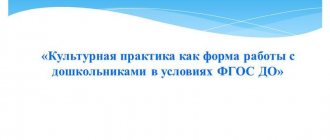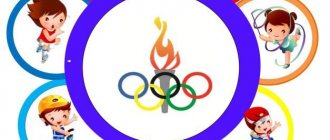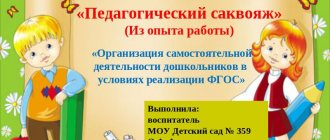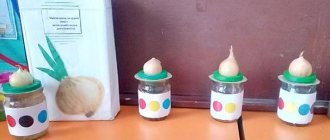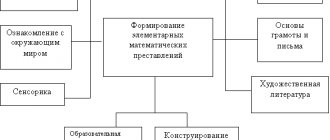Game as a method of musical training in kindergarten
This article is devoted to the study of musical play as a means of organizing active cognitive activity of preschool children, in which creative skills are acquired with ease and interest, initial skills are consolidated and the mental, emotional, and moral development of the child’s personality is carried out. The author of the article cites in support of this all kinds of methodological techniques that he used in practice.
Key words: musical playing, musical-rhythmic movements, “singing to oneself”, singing, listening, “treasury of musical terms”
Play, as the main activity of a preschool child, is an important means of education. V.L. Sukhomlinsky wrote that the spiritual life of children is complete only when “the child lives in the world of games, fairy tales, music, fantasy, and creativity.”
During the lessons there is a musical game, under the conditions of which children study, master and consolidate musical activities. The play form of music classes in kindergarten is created using special play techniques , which, as a rule, are used to facilitate children’s understanding of the essence of a musical work and its artistic features.
Gaming techniques in the process of musical-rhythmic movements.
During classes, a significant part of the time is devoted to learning various movements to music. In the process of systematic movement lessons, children develop musical and auditory perception. Children's musical and rhythmic activity is more successful if the elements of dance movements are taught in combination with techniques that include musical games and creative tasks. Interesting playful creative tasks can be offered to children after listening to a new piece of music again [1, p. 13]. For example, the melody of an unfamiliar polka sounds. Children determine the cheerful, cheerful, danceable nature of the music and say: “This is dance music, it is fun, and you should dance to it easily and cheerfully.” You can invite them to show movements suitable for such music. One of the children may come up with an interesting rhythmic clapping pattern. And now it can be seen in the movements of other children. One by one the guys will join in the dance. The whole group will dance.
For older children, you can use a music center, with the help of which children enjoy listening to children's songs by modern composers. The use of sound recordings in their free time from classes allows children to independently improvise movements and compose simple compositions of dances, round dances, and games.
Young children are characterized by imitative movements. Therefore, it is advisable for them to use a variety of toys in play situations, with the help of which they can encourage children to perform simple actions to the music [2, p. 46]. For example, before a lesson, the music director puts a doll (parsley, bunny, etc.) on his hand and invites children to the hall. Children march happily, imitate all the movements of the doll that it shows: clapping their hands, squatting, spinning, etc. It is more interesting for children to perform dance movements or exercises with a doll.
Gaming techniques in the process of singing.
These musical and gaming techniques are used in the process of singing and help in teaching children to sing expressively and naturally, to learn to take their breath between musical phrases and hold it until the end.
The vocal technique of “singing to oneself” is effective when part of the musical material previously learned by children is performed as usual, and the other part is performed “silently”: it is sung only with the inner ear. A sign to introduce the technique of “singing to oneself” is the facial expression of the music director - exaggeratedly closed lips, giving a conditioned signal: “Singing to oneself.” At the initial stages of using this technique, it is convenient to alternate different manners line by line [1, p. 56]. For example,
- Andrey Sparrow, don’t chase the pigeons. (Aloud.)
- Chase the ticks from under the sticks. (About myself.)
This performance of the song is the simplest. As preschoolers gain singing experience, you can complicate the task by “splitting” the line as follows:
— The clock strikes (out loud)
on the tower (to myself)
- Tick-tock, tick-tock. (aloud)
- And the wall ones - (out loud)
hurry up (to myself)
- Tiki-taki, tiki-taki. (aloud)
- And pocket ones - (out loud)
hurry (to himself)
- Ticky-tock, ticky-tock, ticky-tock! (aloud)
The end of the song is sung out loud so that the children can check their vocal intonation and understand whether they managed to return to the tonic correctly.
This vocal technique can be used with the inner ear when repeating songs. Children are given a task like: “Recognize a familiar song by its introduction and perform it “in your head” at the same time as the melody sounds.” (“Blue Car”, music by V. Shainsky, lyrics by E. Uspensky; “Smile”, music by V. Shainsky, lyrics by M. Plyatskovsky).
Gaming techniques while listening to music.
In the process of listening, children get acquainted with vocal and instrumental works of a different nature and experience certain feelings and emotions. In the works of music teachers (V. Shatskaya, N. Grodzenskaya), attention is paid to the verbal presentation of the impression of a musical work, as it contributes to the development of music mastery, deepens the awareness and emotional coloring of the process itself [3]. There is a real need to develop in preschoolers the ability to characterize music and enrich their artistic and expressive vocabulary.
Using the listening technique “Treasury of Musical Terms” (according to M. Davydova), special work can be carried out to enrich children’s speech with artistic epithets. Any music director is faced with a poor vocabulary of students when determining the nature of a musical work. However, lexical limitation, namely the heterogeneity of the use of various parts of speech, is a common phenomenon that reflects the mental quality of a given age period of children [2, pp. 24–25].
The “piggy bank” option, based on the technique developed by Sh. Amonashvili and used in the structural analysis of a word, can be used in classes with students of senior and preparatory school groups. The technique can be practiced after becoming familiar with musical works. The teacher gives a description of a piece of music, which the children must repeat, but only if the definition is true and not false. For example, children listen to P. Tchaikovsky’s play “The New Doll”.
Music Director : I say this music is fun.
Children (“catch” the word in the cups of their hands, repeat): Cheerful.
Musical director : I say that this music is lively.
Children: Perky.
Musical director : I claim that this music is sad.
Children must notice the mistake and “return” the “caught” word to the teacher.
Next, the teacher offers the following terms in turn: dreamy, menacing, sincere, playful, soft, smooth, scary, sad, sad, joyful, transparent. Of the 12 epithets, seven correspond to the nature of the musical composition. The remaining five (sad, menacing, etc.) must be highlighted by students as incorrect.
If the children made mistakes, then immediately during the work you need to discuss the term - whether it is correct or not. Attention should be paid to the accumulation of synonymous epithets, that is, words that are similar in meaning but different in sound. Below are some example groups of synonyms:
Cheerful - cheerful, playful, rainbow, lively, optimistic, bright, comical, funny, happy, sunny, mischievous, joyful, festive.
Strong - powerful, domineering, intense, sharp, fierce, heroic, angry, courageous, formidable, courageous, courageous.
Tender - soft, affectionate, airy, lyrical, light, warm, pleasant, calm, leisurely, kind, bright.
The level of mastery of musical definition vocabulary acquired by children through the technique of listening to the “piggy bank” can be used when getting acquainted with new works, creating the basis for the skill of giving not single definitions, but entire terminological “chains” of words with similar meanings.
To summarize, it should be said that the systematic use of game situations arouses in children an active interest in music, in the tasks themselves, and also contributes to the rapid mastery of musical material by children. It is the game that makes the learning process interesting and entertaining, and therefore successful.
Literature:
- Dzerzhinskaya I. L. Playing as a means of pedagogical influence on different types of musical activities/I. L. Dzerzhinskaya. - M.: Education, 1999. - 236 p.
- Kononova, N. G. Musical and didactic games for preschoolers: From the experience of music. manager/N. G. Kononova. - M.: Education, 1982. - 189 p.
- Rusinova A. Game technologies in music classes [Electronic resource]: www.maam.ru
